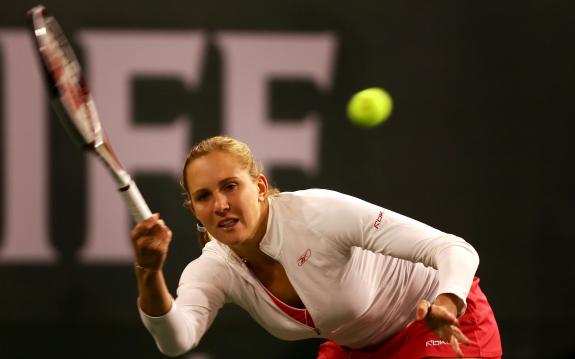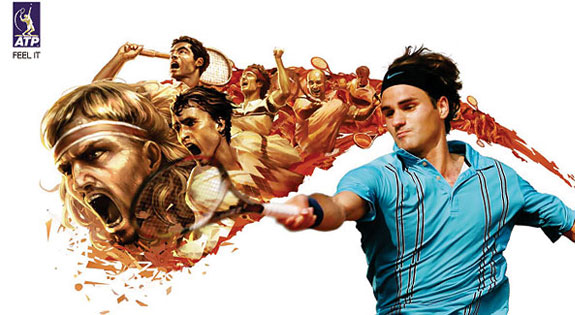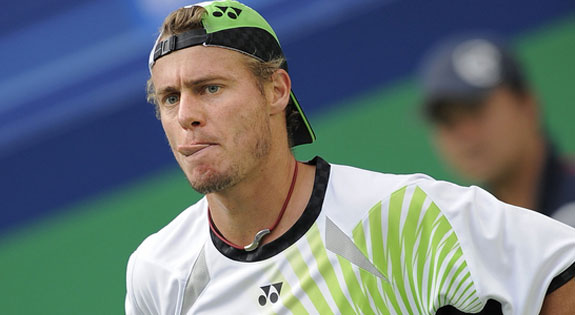By Charles Bricker
Nicole Vaidisova had flung her racket into the red clay, covered her face with her hands in a sort of feigned disbelief, then danced around the Suzanne Lenglen court, blowing kisses to a full stadium — already a fully-grown woman at age 17, on the cusp of greatness and looking very much like someone in love with tennis.

It was only a quarterfinal, but this split-set win over Venus Wiliams at the 2006 French Open was a signature moment in her life, and the way I’d like to remember Vaidisova’s too-short tennis career.
Unfortunately, my sustaining memory of her probably is going to be an uncaring, passionless first-round loss in a $25,000 deep-bush league tournament, where she was beaten 6-2, 6-4 by No. 200-and-something Christina McHale just a couple months ago.
There were no grumpy Vaidisova racket bounces that afternoon and no crumpled Yonexes, and she certainly had destroyed a few of those over the years. There was simply a sense of, “What am I doing here and why am I playing tennis?” It’s a question she won’t have to contemplate any longer.
Her decision to quit the game and marry 31-year-old pro Radek Stepanek probably was made weeks ago, but announced only Tuesday, and I don’t think it’s going to be one of those temporary retirements. Unlike Justine Henin and Kim Clijsters, it’s doubtful she’ll be back because there’s a salient difference among these three women.
Henin and Clijsters love tennis. It doesn’t take much moxie to figure out that whatever affection Nicole once had for playing the game is gone forever, and probably hasn’t been there since she dissolved her coaching relationship with stepfather Alex Kodat two years ago.
Was it one of those classic parent/child coaching disasters? Who can say, aside from Vaidisova and those closest to her, but I doubt it. Kodat is no Jim Pierce. He’s quiet, thoughtful and professorial. There is no doubt he is the one who put in the foundation of Vaidisova’s game and nurtured her to semifinal finishes at Roland Garros and at the 2007 Australian Open.
Their split came at the end of a mysterious slump in 2008 that sent Vaidisova into a rankings freefall, and if there was a defining moment that began this plunge, it was a 6-4, 6-0 loss to Ana Ivanovic in the second round at Dubai, right after Australia.
There followed opening-round losses to Casey Dellacqua at Indian Wells, to Alisa Kleybanova at Key Biscayne, to Gisela Dulko at Berlin, to Ekaterina Makarova at Rome and to Iveta Benesova at the French Open. She lost 10 of 18 matches the remainder of the year, including a first-rounder at the Olympics to Alize Cornet that must have left her particularly dejected.
Maybe, after years of grinding through training, signing autographs, meeting media demands and and being unable to enjoy a more “normal” teenaged life, she lost whatever lust she had for the game, even after banking more than $2.5 million.
Kodat brought her from their home in the Czech Republic to the famed Bollettieri Academy in Bradenton, Fla., when she was 11 and did most of the grooming. When Nicole turned professional at 14 she was well on her way to six-feet tall and with the kind of lower body strength that is essential in tennis. Though she was never going to be among the fastest players on the Sony Ericsson WTA Tour, those long legs covered a lot of court quickly, and she was a devastating ground stroker off both sides.
As she progressed through the 2007 Aussie Open, on the way to the final four, there was no hint of future despair. “I’m definitely very, very happy and excited,” she said after a win. “It’s the first Grand Slam of the year and you don’t know how you’re going to come back from the off-season. But I’ve had a great start to the year and now I just have to keep improving.”
A year later, there were no more smiles in her press conference. She had once charmed reporters with her love of hockey and how she never learned to skate because she was “afraid of the ice.”
And in January, in her final court appearance in a Futures event just outside Tampa, Fla., she was in a deep funk. At one point in this final loss, McHale raced in for a drop shot and bunted it back. Did it bounce once or twice? Vaidisova watched the return on her side of the net and never made a move to play it, despite no “not up” call from the chair umpire.
There will be those who complain about her “wasted talent,” though that seems a bit unfair. You have to have passion to play this game and she no longer has any for tennis. That’s not wasted. It’s just not there.
Charles Bricker can be reached at nflwriterr@aol.com


